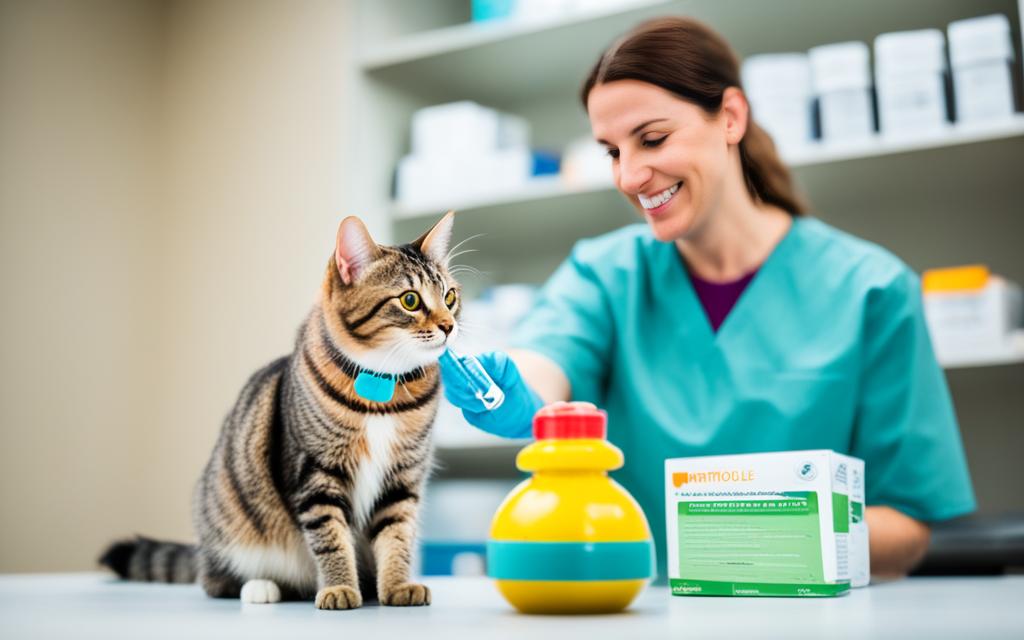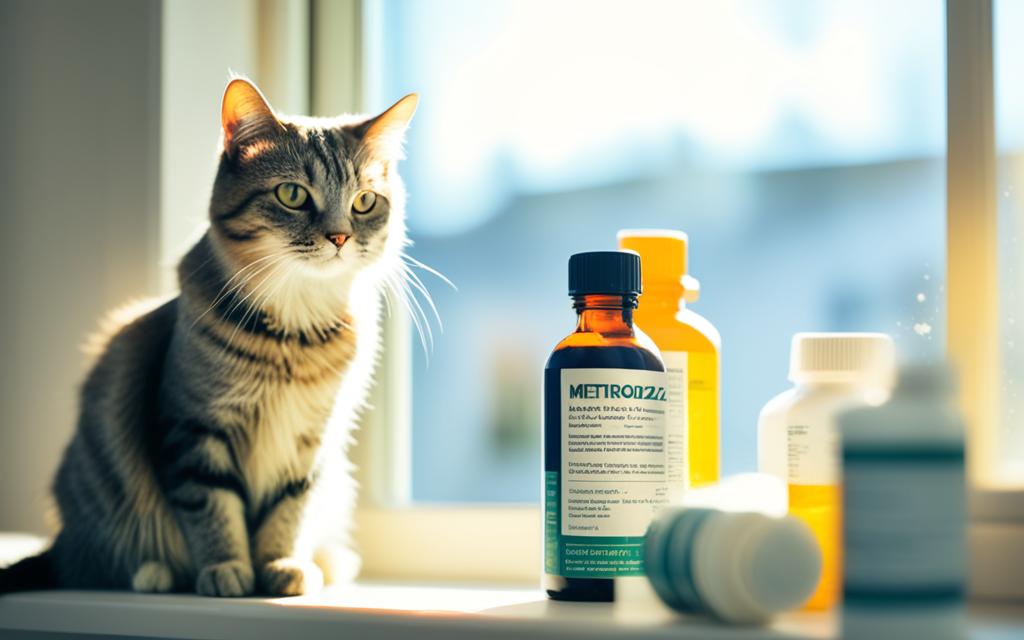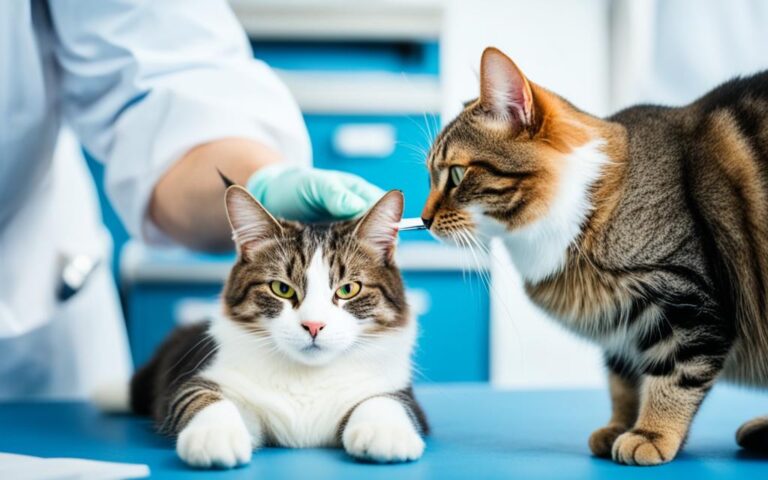Metronidazole for cats: Uses, Dosage & Side Effects Guide
Did you know metronidazole is more than just an antibiotic? Often known by the brand name Flagyl, it treats both infections and parasitic issues in cats1. This guide will tell you how it works, when vets might prescribe it, what side effects to watch for, and answers to common questions. By learning about metronidazole, you’ll be able to help your cat stay healthy.
Key Takeaways
- Metronidazole is an antibiotic and antiprotozoal medication used in veterinary medicine to treat various infections and conditions in cats12.
- Metronidazole comes in different forms, including capsules, tablets, and liquid1.
- Common uses of metronidazole in cats include treating diarrhea, inflammatory bowel conditions, and protozoal infections1.
- Potential side effects of metronidazole in cats may include vomiting, decreased appetite, and neurological symptoms3.
- Metronidazole should be used cautiously in certain cats, such as those with liver disorders or those who are pregnant or nursing3.
Table of Contents
What is Metronidazole?
Metronidazole is a medicine used to fight infections in cats4. It works on some types of bacteria and parasitic protozoa4.
Overview of Metronidazole for Cats
This drug mainly focuses on anaerobic bacteria, which can live without oxygen4. It also fights off certain parasitic protozoa4. By messing with their DNA, it stops their growth, eventually killing them5.
About Metronidazole for Cats
Vets often give Metronidazole to cats for anaerobic bacterial and protozoal infections6. They also use it for stomach and large intestine inflammations6. You can get it in many forms like capsules, tablets, or gels. It’s known by brand names like Flagyl® or Metizol®6.
This drug kills bacteria by hurting their DNA, but not all bacteria6. It’s great for fighting protozoal infections caused by Giardia and others4. It also fights anaerobic bacterial infections4.
Vets might also use Metronidazole with corticosteroids for specific diseases in cats4. It treats some gut issues, gum disease, and bacterial infections caused by other antibiotics456.
Uses of Metronidazole for Cats
Accepted Uses
Metronidazole helps cats with giardiasis, a stomach bug. It fights the infection from Giardia germs. This medicine stops the spread of Giardia through their waste. It also helps get rid of the diarrhea linked to this bug7. This bug is more common in young cats, especially those that live with many other cats. It mainly gets found in cats less than a year old7. Doctors usually treat this bug with a different medicine called fenbendazole. But, metronidazole can work well too. It’s given at a lower dose for 5 days instead of the usual 7-day treatment7.
Metronidazole isn’t officially meant for pets. Yet, vets see it can help with other illnesses like stomach issues, some kinds of liver problems, and brain issues8. But keep in mind, it’s not a sure fix for these uses8.
Potentially Effective Uses
Besides fighting giardiasis, metronidazole might help with another bug called Tritrichomonas foetus8. It can change the immune system’s response, which can be good for stomach problems in cats8.
Metronidazole can address many health problems in cats. These include stomach infections, gum disease, and even severe liver diseases8. Adding this drug to steroids can help ease stomach and gum issues. Yet, the proof isn’t solid for using it this way8.

Remember, using metronidazole for these extra uses is up to the vet. They decide based on what they know and have seen work. Always trust your vet’s advice879.
How Metronidazole Works in Cats
Metronidazole is a powerful antibiotic and antiprotozoal drug10. It works in a special way when it enters a cat’s body. First, it goes into the target cell. Then, it disrupts the DNA of harmful bacteria and protozoa10. This stops them from making new DNA, which kills them10.
With bacteria, metronidazole creates free radicals. These can harm the bacterial DNA, killing the bacteria11. It works similarly against protozoa. Metronidazole can also reduce inflammation in a cat’s intestines, helping with certain diseases10.
| Mechanism of Action | Impact on Bacteria | Impact on Protozoa |
|---|---|---|
| Disruption of DNA structure | Inhibition of nucleic acid synthesis, leading to cell death | Disruption of DNA, causing eradication of parasitic protozoa |
| Generation of free radicals | Damage to bacterial DNA | Disruption of protozoan DNA |
| Anti-inflammatory properties | N/A | Calms bowel inflammation |
To sum up, metronidazole disrupts DNA in bacteria and protozoa, wiping them out. It can also lower inflammation, which is good news for cats with certain diseases1011.
“Metronidazole is a potent antibiotic and antiprotozoal medication that exerts its effects by disrupting the DNA of susceptible bacteria and parasitic protozoa, leading to their demise.”
Metronidazole for cats: Dosage and Administration
The right metronidazole dosage for cats changes with the illness. For diarrhea, use 5-10 mg/kg12. Yet, if it’s Giardia or Tritrichomonas, give 15-25 mg/kg a day13.
Dosage Information
Your vet knows best for metronidazole dosage, fitting it to your cat’s health and the issue at hand14. Remember, it’s off-label but vets can still use it14.
Administering Metronidazole to Cats
Metronidazole works with or without a meal. Mixing it with food might calm stomach irritation14. If the bitter tablet is hard for your cat, a liquid or tasty option might be okayed by your vet14.
How you give it matters. Always finish the dose your vet recommends. Stopping early might not solve the health issue or even create more problems.
| Formulation | Strength |
|---|---|
| Metronidazole Tablets | 250 mg, 500 mg |
| Metronidazole Capsules | 375 mg |
| Metronidazole Liquid | 500 mg vials, 5 mg/mL injectable solution |
The usual metronidazole amount for cats and dogs is 5 to 30 mg for each pound. This is given one to four times daily, based on the illness14. The length of use will depend on how your pet responds to their treatment and if there are any side effects14.
“Metronidazole should be cautiously administered to pregnant pets and avoided in pets with liver disease or if they are on medications like phenobarbital and cimetidine.”14
Side Effects of Metronidazole in Cats
Metronidazole is usually fine for most cats. Yet, owners should know about the side effects of metronidazole in cats and possible adverse reactions to metronidazole in cats. The main issues seen are vomiting, diarrhea, tiredness, weakness, and not wanting to eat1515. If the dose is too high or the cat uses it for a long time, they might show signs like stumbling or having seizures15.
This medicine is often used for cat diarrhea1515. But always keep an eye on your cat and tell your vet if you see worrying signs. Although rare, some severe effects in both cats and dogs can happen, like tiredness, liver issues, and seizures15.
Vets are more careful now when giving this drug to cats15. They know there are other options, like probiotics and changes in diet. Cats and dogs on metronidazole might have effects like more spit, drooling, feeling sick, not wanting to eat, and upset stomach15.
| Potential Side Effects of Metronidazole in Cats |
|---|
| Vomiting |
| Diarrhea |
| Lethargy |
| Weakness |
| Loss of appetite |
| Neurological symptoms (lack of coordination, seizures) |
| Excessive salivation |
| Drooling |
| Gagging |
| Nausea |
| Hepatopathy |
| Central nervous system signs (seizures) |
Metronidazole comes in many forms, like tablets and capsules16. Using too much can hurt your cat and show in ways like wobbling or seizures. Keep an eye out for symptoms and tell your vet right away16.
Watching your cat closely is very important. Knowing about side effects helps you and your vet keep your cat safe during treatment.
Precautions for Using Metronidazole in Cats
Metronidazole is a key drug in vet medicine17. But, it’s crucial to be careful when giving it to cats. This drug is linked to cancer and genetic changes. This is especially important to remember for pregnant or nursing cats17.
Carcinogenicity and Mutagenicity
Lab studies have found metronidazole can cause cancer with long-term use17. It also shows a risk of genetic changes in lab tests17. So, using it for too long or too often in cats isn’t a good idea.
Pregnancy and Lactation Considerations
Metronidazole can pass to baby cats and get into their milk2. While it hasn’t proven to cause birth defects, its use in pregnant or nursing cats must be weighed well2. Avoid using it in cats meant for breeding food animals2.
Drug Interactions
Certain meds, like cimetidine, can affect metronidazole’s levels in the body18. Always tell your vet about your cat’s medications. This can prevent dangerous interactions2.

Be extra cautious when you use metronidazole in cats17. Remember its cancer and gene-changing risks. Think twice before using it with pregnant animals2. Also, be aware of possible harmful interactions with other drugs18.
Always work closely with your vet. Together, ensure you help your cat safely with this medicine17218.
Metronidazole for cats
Metronidazole is used a lot in vet care, especially for cats. It fights off bacterial and parasitic infections, which are common causes of diarrhea. But, it’s key to remember that this medicine, when used for a long time, might have some bad effects3.
It is FDA-approved for people under the name Flagyl. Yet, it’s regularly used for animals too. This treatment for cats comes in different forms like pills, liquids, and injections. This flexibility helps the vet pick the best form for each cat31.
When managing metronidazole for cats, following the vet’s plan is a must. Look out for any side effects, such as upset stomach, or changes in behavior. And if you notice something’s off, it’s time to call the vet31. Some cats might also show liver problems or have a rare skin disease. These signs mean a quick trip to the vet is needed31.
If a cat has liver issues, is a baby, takes blood thinners, or other certain medicines, ask the vet before giving metronidazole32. Female cats who are pregnant or nursing also shouldn’t take it. And if a cat is allergic to it, they must avoid this medicine3.
Storing metronidazole right is important to keep it effective. Always put pills and liquids in a safe, cool place away from light. And, for liquids, follow if the vet says to keep it in the fridge3.
In an emergency like too much medicine, or if your cat seems very sick, call the vet right away3.
Metronidazole can really help cats, but using it safely is crucial. Make sure to keep a close eye on your cat’s reaction to this medicine321.
| Relevant Statistical Data on Metronidazole for Cats |
|---|
| Metronidazole is used to treat certain anaerobic bacterial and protozoal infections in cats, such as those caused by Giardia and Trichomonas3. |
| Many drugs used for treating animals in veterinary medicine, including metronidazole for cats, are prescribed off-label3. |
| Metronidazole comes in various forms for cats, including capsules, tablets, liquid suspensions, and injectable formulations31. |
| Administration of metronidazole should be done orally with food, usually taking effect within one to two hours3. |
| Side effects of metronidazole in cats may include nausea, vomiting, diarrhea, decreased appetite, and drooling31. |
| Neurological effects from metronidazole in cats may include lack of muscle control, tremors, seizures, eye twitching, and weakness31. |
| Liver toxicity is a potential adverse effect of metronidazole in cats, with symptoms like inappetence and yellowing of skin, eyes, or gums31. |
| Cutaneous vasculitis, a skin disorder, is a rare side effect of metronidazole in cats, showing signs like scaling, bruising, and swelling31. |
| Metronidazole should not be used in pregnant or nursing cats and those with known hypersensitivity or allergies to the drug3. |
| Caution must be taken when using metronidazole in cats with certain liver disorders, puppies or kittens, and those on blood thinners32. |
| Metronidazole may interact with other drugs like chemotherapy agents, cyclosporine, and phenobarbital, potentially causing risks in cats32. |
| Monitoring for the efficacy and adverse effects of metronidazole in cats is essential during the treatment period3. |
| Metronidazole tablets, capsules, and oral solutions for cats should be stored in a tightly sealed container, protected from light, and below 30°C3. |
| Liquid formulations of metronidazole for cats may need refrigeration as per special storage instructions from the veterinarian3. |
| In case of an emergency like overdose or adverse reaction to metronidazole in cats, contacting the veterinary office or an emergency facility promptly is recommended3. |
Pharmacology and Pharmacokinetics of Metronidazole
Metronidazole is used as an antibiotic and antiprotozoal. It works by messing up the DNA of bacteria and protozoa19. When it gets inside a cell, it changes form and hurts the DNA. This leads the cell to die. For bacteria, stopping DNA from working is how it works19. For protozoa, it makes free radicals. These harm the DNA of the parasites19.
Mechanism of Action
Metronidazole’s way of working starts when it’s changed in a cell to harm DNA. This DNA damage stops the cell from making new DNA and it dies19. For bacteria, not making new DNA is the main effect. But, for protozoa, it’s about damaging DNA with free radicals19.
Absorption, Distribution, and Elimination
Cats and dogs absorb metronidazole pretty well into their body after taking it by mouth19. Once in the body, it spreads evenly and reaches where it’s needed, like in fluids around organs and in the brain’s fluid20. The liver handles most of the volume changes. It gets rid of metronidazole in about 3 to 4.5 hours in dogs and horses21.
In cats, the body uses about 65% of metronidazole taken by mouth21. And, it takes a bit longer for the body to fully clear it compared to dogs21. Meaning, cats’ bodies keep metronidazole around for 5 to 6 hours. Dogs’ bodies do it for a shorter time21.
The highest amount of metronidazole in the body after taking it by mouth happens between 1 to 8 hours later21. Also, less than 20% of metronidazole sticks to proteins in human blood21.
Conclusion
Metronidazole is a common drug for treating various infections and conditions in cats22. It works against specific bacteria and parasites. This is helpful for issues like diarrhea and some diseases of the bowel22. But, it has some risks, like being potentially cancer-causing with long use23. Always follow your vet’s advice closely when using this medication. Watch for any bad reactions in your cat.
Metronidazole is widely used for cat health but with care because of side effects22. It might not always work well for every health issue, like acute diarrhea2423. A big picture of metronidazole for cats shows its many uses and possible benefits. Yet, it highlights the importance of having a vet closely manage its use.
Discounts on prescriptions, like with CareCard, can make metronidazole more affordable for cat owners22. Knowing the basics of metronidazole treatment helps cat owners work better with their vet. Together, they can ensure the best and safest care for their feline friend.
FAQ
What is metronidazole and how is it used in cats?
What are the common uses of metronidazole in cats?
How does metronidazole work to kill bacteria and parasites in cats?
What is the typical dosage of metronidazole for cats?
Are there any potential side effects of metronidazole in cats?
Are there any special precautions when using metronidazole in cats?
Can metronidazole interact with other medications in cats?
Source Links
- Metronidazole for Cats: Uses, Dosage & Side Effects – Cats.com
- Metronidazole for Dogs and Cats
- Metronidazole | VCA Animal Hospitals
- Metronidazole for Veterinary Use
- Mar Vista Animal Medical Center
- Uses, Dosage, and Side Effects
- Metronidazole Tablets
- Metronidazole for the treatment of feline giardiasis – PubMed
- Can you use metronidazole for cats?
- Metronidazole in Vet Medicine – Facts and Information | PetCoach
- Microsoft Word – Metronidazole Final 2007 2-column.doc
- Feline Colitis – WSAVA 2014 Congress
- Metronidazole (Flagyl®) for Dogs and Cats – PetPlace
- Rethinking the role of metronidazole in veterinary medicine | IVC Journal
- Metronidazole Benzoate – an overview
- Metronidazole for Cats: Our Vet Explains the Dosage, Uses & Side Effects – Catster
- No title found
- Single-dose pharmacokinetics and genotoxicity of metronidazole in cats
- Models describing metronidazole pharmacokinetics in relation to hemodynamics in turkeys – PubMed
- Metronidazole For Cats: A Guide To Treatment And Cost Savings | CareCard
- Think metronidazole works? Maybe not so much
- The Effect of Metronidazole versus a Synbiotic on Clinical Course and Core Intestinal Microbiota in Dogs with Acute Diarrhea







